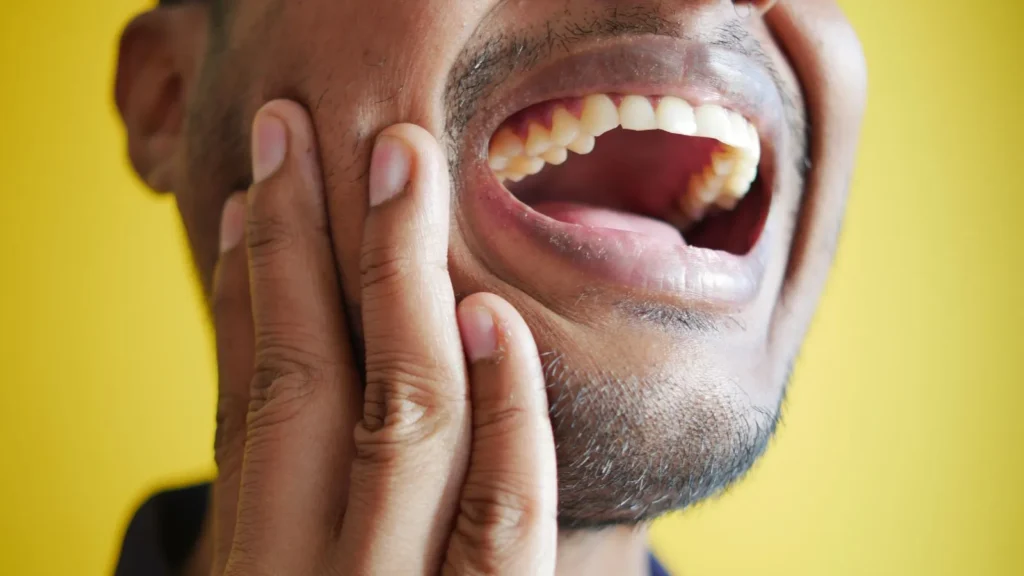Pain around your jaw. Tension in your temples. That dull ache after eating, or a pop you feel every time you yawn. It’s easy to dismiss at first, until it starts happening more often. For many people, this kind of recurring discomfort points to TMJ dysfunction, a condition involving the temporomandibular joint that can cause lasting issues with the jaw and face.
At Tonic Physio, we work with people who experience this kind of jaw pain every day. Some come in with a diagnosis. Others just know something doesn’t feel right. Either way, our focus is the same: to help reduce the pain by providing TMJ treatment with physiotherapy, improve movement, and figure out what’s really behind the problem.
TMJ Dysfunction and Its Symptoms
The temporomandibular joint (TMJ) is the hinge that connects your jawbone to your skull, right near your ears on both sides. It’s the part of your body that lets you open and close your mouth, chew your food, speak clearly, and yawn without discomfort.
It’s a small joint, but it’s one of the most active in the body. And because it works with surrounding muscles, ligaments, and nerves, any disruption in how it moves can quickly lead to tension or pain across the face, head, and neck.
What Is TMJ Dysfunction?
TMJ dysfunction happens when the joint stops moving as smoothly as it should. This could be due to inflammation, muscle tension, joint misalignment, or issues with how the teeth meet. In some people, it’s triggered by grinding their teeth at night. In others, it’s linked to stress or even poor posture at work.
You don’t need a major injury for TMJ dysfunction to show up, often, it builds over time. Once it starts, the muscles around the joint often try to “help” by tightening up, which can make things worse.
Common Symptoms of TMJ Dysfunction
TMJ symptoms don’t always feel like jaw pain. Many people are surprised to learn that their headaches or ear discomfort are connected to this joint. Some of the signs you can notice include:
- A dull ache in or around the jaw
- Clicking, popping, or shifting when you open or close your mouth
- Stiffness or tension in the jaw, temples, or neck
- Pain when eating, chewing, or yawning
- Earaches or pressure without any signs of infection
- Headaches that seem to start at the sides of the face
- A tired or sore feeling in the jaw, especially in the morning
These symptoms often start small but can build gradually. For many people, they start to affect eating, talking, focus, and sleep.
These symptoms don’t always go away on their own. If they start affecting how you eat, speak, or sleep, it may be time to look at treatment. At Tonic Physio, we use physiotherapy for TMJ treatment to help reduce discomfort, improve movement, and take pressure off the areas doing too much work.

What Causes TMJ Disorders?
The temporomandibular joint works hard. It’s supported by muscles, ligaments, nerves, and connective tissue; all of which need to move in sync. When even one part of that system is off, the rest tends to compensate. Over time, that strain builds into dysfunction.
Several common issues can contribute to TMJ problems. Although not every case looks the same, these are some of the most frequent triggers we see at our clinic:
1. Teeth Grinding and Jaw Clenching (Bruxism)
Grinding your teeth at night or clenching your jaw during the day puts constant pressure on the joint. It’s often unconscious, as many people don’t realize they’re doing it until they start waking up with headaches or jaw stiffness.
According to the Canadian Dental Association, nearly 1 in 3 adults experience some form of bruxism, especially during periods of high stress. Over time, this habit can overwork the jaw muscles and irritate the joint itself.
2. Stress and Tension Holding
Stress doesn’t just affect your mind. It shows up physically: in your shoulders, your neck, and often your jaw. People under ongoing stress tend to hold tension in these areas without realizing it, which can tighten the muscles around the TMJ and disrupt how the joint moves.
We see this frequently in clients with desk jobs, caregivers, students, or anyone juggling a lot at once. The link between emotional tension and jaw pain is stronger than most people expect.
3. Poor Posture and Head Position
Posture plays a bigger role than you’d think. Spending hours hunched over a screen shifts the position of your head and neck, which changes how your jaw sits. Over time, that imbalance can strain the TMJ.
This is especially common in people who sit at computers all day without ergonomic support. If your head juts forward even slightly, the muscles that support the jaw are forced to work harder just to keep things aligned.
4. Jaw Injuries or Dental Work
A direct injury to the jaw (like a hit, fall, or whiplash) can damage the joint or surrounding muscles. Even something as routine as extensive dental work can occasionally trigger symptoms, especially if your mouth is held open for long periods.
These types of causes tend to be more acute, but they can still lead to chronic problems if the tissue doesn’t recover fully or if scar tissue limits movement.
5. Joint Misalignment or Structural Issues
Sometimes, the bones or cartilage in the joint don’t move as they should. That could be due to genetics, arthritis, or wear and tear over time. In some cases, the disc that cushions the joint slips out of place, causing clicking, locking, or pain.
This is less common than muscular causes, but it can play a role and it’s something we always assess during your initial TMJ treatment with physiotherapy evaluation.
Understanding these root causes isn’t just helpful, but it’s key to choosing the right treatment. If your TMJ dysfunction is muscle-based, a hands-on, movement-focused approach like TMJ treatment with physiotherapy can address the problem directly.
But if it’s structural or linked to an underlying condition, your physiotherapist can help coordinate with dental or medical providers as needed.

TMJ Treatment with Physiotherapy for Pain Relief
Most people with jaw issues try to manage it themselves first: soft foods, a hot compress, sometimes anti-inflammatories too. It can take the edge off, but the problem keeps coming back.
TMJ treatment with physiotherapy works differently. It looks at the muscles, joints, and movement patterns that are causing the tension in the first place. It doesn’t just ease symptoms, but it retrains your jaw to work properly again.
What to Expect from TMJ Physiotherapy:
Your first visit usually starts with a one-on-one assessment. The physiotherapist will examine how your jaw moves, feel for tight or overactive muscles, and check the connection between your jaw, neck, and posture.
Based on this, your treatment plan can include:
-
TMJ Massage Therapy
Tension around the jaw and face can lock things up fast. TMJ massage therapy targets the key muscles involved in chewing, speaking, and clenching, especially the masseter, temporalis, and sometimes the pterygoids (via gentle intraoral techniques).
By releasing these pressure points, you’ll often feel relief in your jaw, temples, or even down the neck within just a few sessions.
-
Joint Mobilization and Manual Techniques
If your jaw joint is not gliding the way it should, small mobilizations can help realign and free up that movement. Your physiotherapist may apply slow, guided movements to encourage better mechanics and reduce irritation in the joint.
This step is especially helpful in TMJ disorder treatment, where stiffness or jaw locking is part of the problem.
-
Posture and Neck Support
For many people, the root of jaw pain isn’t the jaw itself, it’s the posture pulling everything out of alignment. Slouching, forward head posture, and stress-driven shoulder tension can all affect the way your jaw moves.
TMJ physiotherapy includes postural correction and neck therapy, using exercises and hands-on care to reset how your upper body holds itself throughout the day.
-
Custom Exercises to Build Long-Term Relief
Quick relief is nice. Long-term change is better, that’s why your treatment plan will also include personalized home exercises: from gentle jaw stretches to tongue placement and postural resets. These tools are simple, repeatable, and designed to help you take control of your recovery.
If you’re looking for treatment of TMJ disorders that changes the way your jaw functions (not just numbs the pain) this is the work that makes the difference.
How Long Does TMJ Treatment Take?
There’s no one-size answer, but most clients notice improvement within the first 3–5 sessions. For some, just a few targeted appointments resolve the issue. For others, especially where stress, posture, or long-term clenching is involved, treatment may continue for a few months.
Your physiotherapist will track your progress and adjust the plan as you go. What’s important is that TMJ treatment near you shouldn’t feel like a never-ending process; it should feel like you’re gaining more control, comfort, and function every week.
And no, you don’t have to wait until it’s “really bad” to start. The earlier you get assessed, the easier it is to treat.
When to See a TMJ Specialist Near You?
If your jaw tension, clicking, or headaches are starting to affect your daily comfort, then it’s time to speak with a temporomandibular joint disorder specialist.
At Tonic Physio, our team uses focused TMJ treatment with physiotherapy to help reduce tension, restore movement, and improve function. You don’t need a referral to get started.
Even if you’ve been managing symptoms for a while, a quick assessment can help you understand what’s going on and what you can do about it.

Common TMJ Treatment with Physiotherapy FAQs
-
Does TMJ go away on its own?
TMJ dysfunction can improve for some people, but it often persists or worsens without treatment. Physiotherapy can address the root causes, like muscle tension or jaw alignment.
-
Should I see a physiotherapist or a dentist for TMJ?
If your TMJ symptoms are related to muscle pain, tension, or jaw movement, a physiotherapist is often the better first step. Dentists focus more on bite alignment and dental issues.
-
Can I still get treatment if I’ve had symptoms for years?
Yes. Even long-standing TMJ dysfunction can respond well to physiotherapy. Many patients see relief within a few sessions, even after years of discomfort.
-
Is TMJ treatment covered by insurance?
TMJ treatment with physiotherapy is often covered by extended health benefits. Coverage depends on your provider. Tonic Physio can help with receipts for reimbursement.
Ready to Feel Relief from TMJ?
Jaw pain doesn’t have to be something you just live with. At Tonic Physio, we take a hands-on, personalized approach to TMJ treatment with physiotherapy, helping you move better, feel better, and get back to eating, speaking, and sleeping without discomfort.
Just book a quick assessment with our team, and we’ll guide you from there.
Book Your TMJ Treatment Appointment Today
Or get in touch with any questions you have. We’re here to help.







